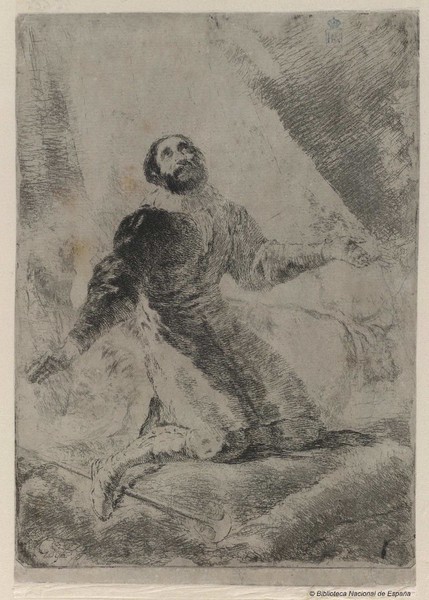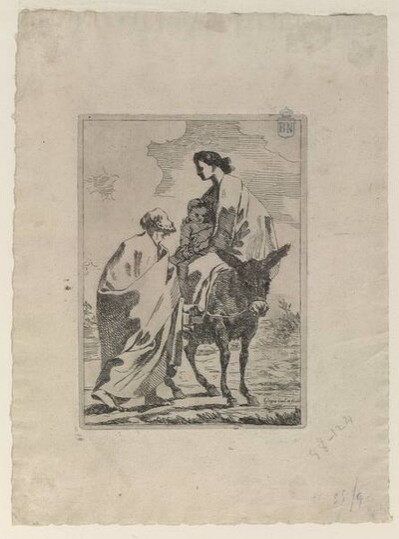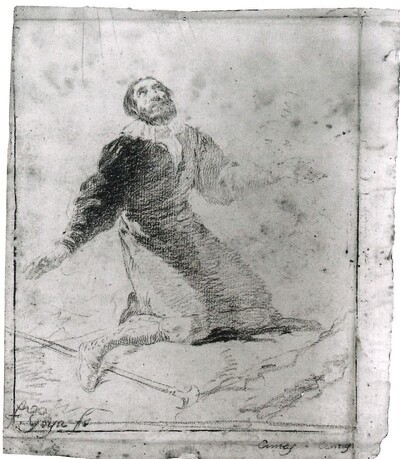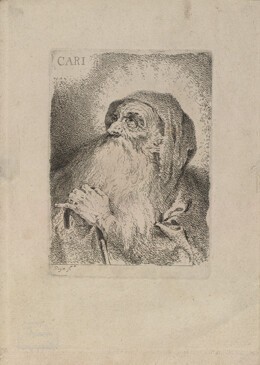- Cronología
- Ca. 1778 - 1782
- Dimensiones
- 230 x 168 mm
- Técnica y soporte
- Etching and drypoint on laid paper. Plate with corners cut off. The print has been retouched by hand
- Reconocimiento de la autoría de Goya
- Undisputed work
- Titular
- National Library of Spain
- Ficha: realización/revisión
- 07 Nov 2010 / 31 May 2023
- Inventario
- 225
Signed Goya (lower left-hand corner).
This one-off proof came from the Valentín Carderera Collection and is now in the National Library in Madrid. The reason that only this one proof has survived is that Goya discarded the plate after seeing that he had failed to resolve the foul bite problem in the background.
This etching, belonging to the series on religious subjects, shows Goya handling the technique of etching more deftly than in The Flight to Egypt. Here we see Madrid's patron saint kneeling to pray, with his arms held out in the shape of the cross, and the flank of an animal off to one side. Behind, Goya has engraved a yoke of oxen led by an angel, whose wings can only just be made out in the impression. The figure of the saint is lit up by a ray of light that falls down from above. San Isidore is looking upwards, his eyes turned to heaven in an attitude of prayer, in keeping with the position of his arms and recalling the painting Christ on the Mount of Olives as well as the first engraving in the Disasters of War series. Goya has rendered the saint's clothing using short horizontal lines which become more intense in the centre of his body and on his left shoulder.
Dating this work presents some difficulties but two pieces of information allow us to establish its time of execution to around the end of the 1770s. The first clue is that it was on exactly the 15th November 1779 that, according to the Gazeta de Madrid, the remains of Saint Isidore the Labourer were transferred to the church of El Sacramento in Madrid. The second piece of information that points to Goya having made this work around that time is the discovery, on the back of the proof ofSaint Isidore the Labourer, of a black pencil study of Velázquez's portrait of the Infante Balthasar Charles on horseback. Goya made a print of this work by the Sevillian master which was published in December 1778 and it is likely that he would have made a preliminary drawing first and then reused it later for the first proof of Saint Isidore.
This etching has recently undergone restoration work and been removed from the support which it was previously stuck to. This made it possible to view the sketch that Goya made of Velázquez’s equestrian portrait of Prince Balthasar Charles.
-
The Changing Image: Prints by GoyaMuseum of Fine ArtsBoston1974From October to December 1974. Exhibited also at The National Gallery of Canada, Ottawa, January to March 1975cat. 2
-
Goya. Das Zeitalter der Revolucionen. Kunst um 1800 (1980 – 1981)Hamburger KunsthalleHamburg1980p. 258, cat. 213
-
Goya. El Capricho y la Invención. Cuadros de gabinete, bocetos y miniaturasMuseo Nacional del PradoMadrid1993from November 18th 1993 to February 15th 1994. Exhibited also at the Royal Academy of Arts, London, March 18th to June 12th 1994 and The Art Institute of Chicago, Chicago, July 16th to October 16th 1994, consultant editors Manuela B. Mena Marqués and Juliet Wilson-Bareaucat. 2
-
Ydioma universal: Goya en la Biblioteca NacionalBiblioteca NacionalMadrid1996from September 19th to December 15th 1996cat. 69
-
Goya y Zaragoza (1746-1775). Sus raíces aragonesasMuseo Goya. Colección IbercajaZaragoza2015cat. 27
-
Goya, grabadorMadridBlass S.A.1918cat. 3
-
Goya engravings and lithographs, vol. I y II.OxfordBruno Cassirer1964cat.2
-
Vie et ouvre de Francisco de GoyaParísOffice du livre1970cat. 53
-
Catálogo de las estampas de Goya en la Biblioteca NacionalMadridMinisterio de Educación y Cultura, Biblioteca Nacional1996cat.2
-
Goya y Zaragoza (1746-1775). Sus raíces aragonesasZaragozaFundación Goya en Aragón, Ibercaja y Gobierno de Aragón2015pp. 164-165



